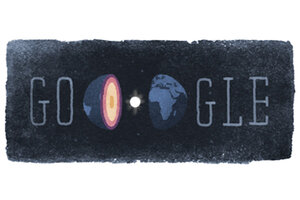Google celebrates Inge Lehmann, discoverer of Earth's inner core
On what would be Inge Lehmann's 127th birthday, a Google Doodle pays homage to the influential Danish seismologist.

Google commemorated the 127th birthday of Inge Lehmann, who discovered the Earth's inner core, on Wednesday.
Screenshot
In today’s Google Doodle, a cross-section of Earth spins in honor of Inge Lehmann, the Danish seismologist who discovered the planet’s inner core.
By observing how seismic waves behaved as they approached the core, Dr. Lehmann revised our understanding of the Earth below our feet. Today, on what would be her 127th birthday, her model remains virtually unchallenged in the scientific community.
The Earth’s core is famously difficult to map out. Even if we could dig a hole the 2,000 or so miles deep it would take to reach the outer core, the extreme heat and pressure would make it completely inhospitable to humans and robotic probes alike. In the absence of firsthand evidence about the makeup of the core, any research must rely on deduction.
In the 1880s, modern seismometers made it possible to detect earthquakes with increasing accuracy. These devices could pick up both P-waves, which are high-velocity compressions caused by earthquakes, and S-waves, the slower elastic waves that follow. At the beginning of the 20th century, savvy seismologists like Beno Gutenberg began using seismometers a bit like X-ray machines for our planet.
Gutenberg noticed that when an earthquake occurred in one part of the world, seismic waves didn’t travel through to the opposite side – S-waves seemed to have little trouble passing thousands of miles through rock, but the waves expected to pass through the center of the Earth seemed to stop dead.
P-waves, by contrast, did pass through the center of the Earth, but they seemed become more focussed as they did so, creating "shadow zones" – empty regions on either side where no waves were detected. Gutenberg theorized that the core must be composed of molten rock, since S-waves cannot travel through liquids and P-waves are refracted by them.
But there was one problem: some seismometers did detect faint P-waves in what was supposed to be the empty P-wave shadow zone. Most seismologists chalked it up to measurement error. But Lehmann, whose career as a geophysicist had already spanned a decade, had another idea. In a 1936 paper entitled P' ("P Prime"), she proposed a solid inner core surrounded by a molten outer core. It was a simple solution, but one that completely explained seismologists' observations – a solid inner core would reflect P-waves, causing them to end up in the shadow zone.
Her theory was rapidly adopted by others in the field, including Gutenberg.
Later, Lehmann would discover a depth at which P-waves and S-waves suddenly increase in velocity. The effect, which still isn’t completely understood by geophysicists, was dubbed the “Lehmann discontinuity” in her honor.
As deadly earthquakes continue to hit Nepal, the importance of seismology can’t be overstated. Over the course of her life, Lehmann contributed decades of study to the field. But the “only Danish seismologist,” as she called herself, is part of a much larger scientific tradition. One that strives to take human minds where human bodies cannot go.
Today, drones can survey disaster areas, fly through war zones, and hover over volcanoes. Rovers can traverse Martian landscapes while feeding photos and data back to Earth. A lot has changed, but there are still places – like the center of the Earth – that our most advanced technologies can’t reach. In those cases, perhaps human ingenuity, like that possessed by Inge Lehmann, might be our best tool.

